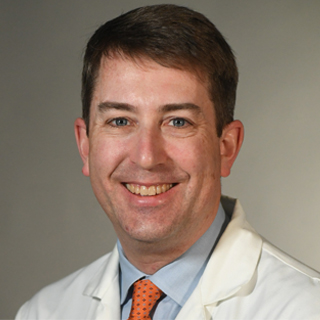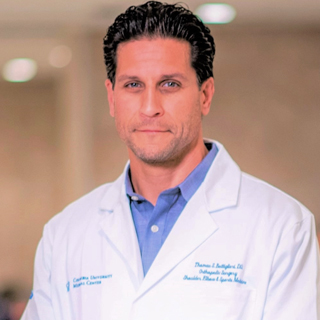Concussions in Sports: What to Know about the Signs, Symptoms, and Treatment
Two experts explain how athletes can spot warning signs of a concussion and why it’s important they get timely care.


Injuries are a risk in any sport, but in high-contact sports like football, hockey, soccer, rugby, lacrosse, and boxing, one type of injury needs particular attention: concussions.
A concussion is an injury to the brain that results in temporary loss of normal brain function. It is the most common form of mild traumatic brain injury, often sustained from a blow to the head after a fall or an accident or during contact sports.
“Referees can stop a game if they suspect a person has a concussion, and coaches can pull a player, but because most concussions are self-reported by the athlete, they often go undiagnosed,” says Dr. James Noble, a neurologist with NewYork-Presbyterian/Columbia University Irving Medical Center.
Players will often try to hide signs of a concussion so they can keep playing, he adds, so having an advocate on the sidelines to reduce the stigma of saying you’re hurt or experiencing symptoms like dizziness or lightheadedness can make a big difference in getting people to report and get treatment for a concussion.
Dr. Thomas Bottiglieri, a sports medicine physician with NewYork-Presbyterian/Columbia, says coaches, referees, parents, and teammates all have a responsibility to protect the brains of athletes.
“If someone has concussive symptoms, whether they’re a high school athlete, a weekend warrior, or they play at an elite level, they need to get checked out,” Dr. Bottiglieri says. “It’s that simple.”
Here, Dr. Bottiglieri and Dr. Noble share how to prevent, spot the signs and treat concussions so athletes of all ages can reduce their risk of head injuries and safely play the sports they love.

Dr. James Noble
What happens to your brain when you get a concussion?
Dr. Noble: A concussion is a type of traumatic brain injury which shows no changes on standard brain imaging but affects how brain cells function. This can happen with a hard blow to the head or from an accumulation of low-impact hits. When your head is hit or jostled, the sudden brain movement can cause your nerve cells to stretch or be damaged, and this can result in the common symptoms of a concussion.
What are the signs of a concussion?
Dr. Bottiglieri: The most obvious signs of a concussion, like loss of consciousness, involuntary movements like a seizure, head-shaking, or major changes in balance or coordination, do not show up in most concussions. If they do, there should be no question as to the removal from play and evaluation with a doctor. Most people have silent symptoms, which include:
- Headache
- Dizziness and poor balance
- Blurred vision
- Sensitivity to light and sound
- Tiredness or sleep disturbance
- Memory problems or confusion
- Nausea
If someone is hurt enough to notice any of these symptoms during practice or competition, they should stop playing, and let someone on the sideline know. If the symptoms persist or get worse, they should tell a member of the team staff and seek further medical attention.
What’s the best way to prevent a concussion?
Dr. Bottiglieri: Not getting hit in the head is what prevents concussions. Helmets and padding offer some protection, but there’s no concussion-proof helmet. If you can limit contact to the head, you can limit concussions. This is why many sports have changed their rules to make hits to the head illegal. But athletes also need to be held accountable if they break these rules. If there’s egregious head-to-head contact and there’s no penalty, it sends the message that this is acceptable and is the nature of the sport. The rules are there to reduce the risk of head injuries, so the rules must be enforced if we want to protect our athletes.

Dr. Thomas Bottiglieri
How is a concussion diagnosed?
Dr. Bottiglieri: Symptom reporting by the injured athlete remains the most important factor for diagnosing a concussion. Concussions won’t be detected on routine brain imaging, though we do sometimes get CT scans or MRIs to check for complications like brain bleeding or a fractured skull. So unless there’s an outward sign, we rely on self-reporting and examination. This is challenging because it means we rely on children, adolescents, and highly motivated collegiate or professional athletes to report an injury during practice or a contest. The desire to keep playing versus the potential for catastrophic injury can lead to conflict for individuals who might not want to admit they are injured. But if an athlete says they have any symptoms of a concussion, they should be pulled and checked out by a medical professional. A trusted health care partner in an athletic program or a physician is essential for accurate decision making and timing of return to play.
Dr. Noble: The worst-case scenario is not reporting symptoms and then getting another head injury before the brain is healed. If someone hasn’t fully recovered from a concussion, returns to the sport too early and then gets hit in the head again, the new brain injury can be far more serious. That’s why it’s important to teach athletes from a young age that it’s OK to say they’re hurt. They should be cleared to play by their doctor before returning to the sport.
What should you do to recover from a concussion?
Dr. Bottiglieri: If diagnosed with a concussion, activities that require focus and concentration, like reading, writing or working on a computer, should be limited for the first few days after a concussion, or only done if feeling well and not causing worsening of symptoms. The same way a pitcher would rest their arm if they sprain their elbow, you want to give your brain time to heal. At the same time, athletes should not completely avoid all these activities, as being away from friends, family, and the routines of life can be upsetting too, especially for young athletes.
Exercise is also key to recovery. Gradually introducing exercise is therapeutic and promotes healing. If concussive symptoms start to subside after a day or two of rest, the person can do some light aerobic exercises. If the symptoms get worse, they should stop. But if they’re able to handle a brisk walk or 15 minutes on a stationary bike, then more intensive workouts can be gradually introduced. Sometimes there are other injuries which happen with a concussion like whiplash (a neck sprain), and for that we may advise physical therapy.
Is it safe to go to sleep after a concussion?
Dr. Noble: There is a myth that after a concussion a person should not go to sleep. The key issue is it is important to be able to observe someone for a few hours after they have had a concussion. For instance, during that time window there is a serious, but thankfully rare, complication that may occur: a life-threatening bleed in the head. So if someone looks like they are going to sleep shortly after being pulled to the sideline, or they look tired and unwell within the first hour or two after a concussion, they should see a medical professional quickly.
Dr. Bottiglieri: Sleep is one of the most important parts of treatment. It’s restorative, regenerative, and it’s one of the key things we emphasize in concussion treatment. With all the pressures of academics, work, and sports, it’s important to emphasize to athletes the need to take time to focus on recovery, with an aim to have life and sports return to normal as soon as possible.
Thomas S. Bottiglieri, DO, is a sports medicine physician with NewYork-Presbyterian/Columbia University Irving Medical Center and an assistant professor of sports medicine at Columbia University Vagelos College of Physicians and Surgeons. He specializes in the management of orthopedic injuries and disorders and is a nationally recognized expert and researcher in the field of concussion care.
James Noble, MD, MS, is a neurologist with NewYork-Presbyterian/Columbia University Irving Medical Center and an associate professor of neurology at Columbia University Vagelos College of Physicians and Surgeons. He primarily sees patients with dementia but is also involved in multidisciplinary clinical and research efforts to support patients with persistent post-concussive symptoms. Dr. Noble is the co-editor of the 14th edition of Merritt’s Neurology, a standard global neurology textbook, and he is working with the engineering department at Columbia University to develop technology to better diagnose concussions.
Additional Resources
Learn more about concussion services at NewYork-Presbyterian.

